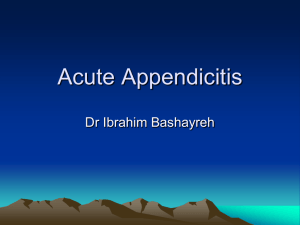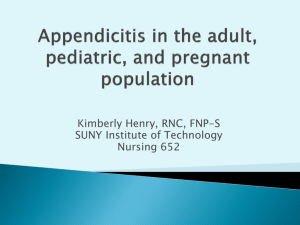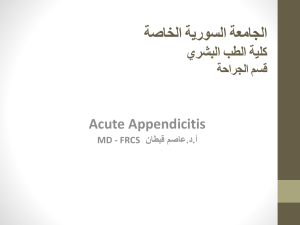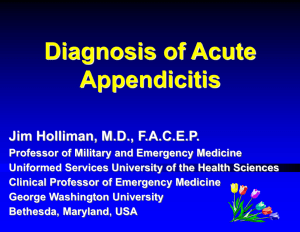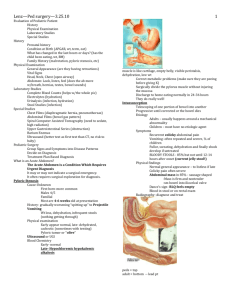Acute Appendicitis
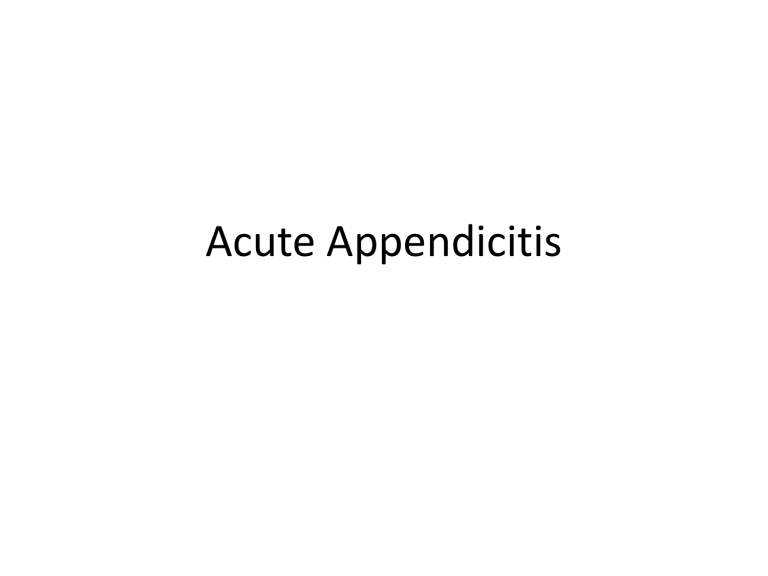
Acute Appendicitis
Epidemiology
• The incidence of appendectomy appears to be declining due to more accurate preoperative diagnosis.
• Despite newer imaging techniques, acute appendicitis can be very difficult to diagnose.
Appendicitis:
• The most common surgical condition of the abdomen
• Lifetime occurrence of 7%
• Peak incidence 10-30y
• The most common nonobstetric surgical intervention during pregnancy
Pathogenesis:
• Appendiceal lumen obstruction : lymphoid hyperplasia fecaliths parasites foreign bodies crohn’s disease metastatic cancer carcinoid syndrome
Pathophysiology
• Acute appendicitis is thought to begin with obstruction of the lumen
• Obstruction can result from food matter, adhesions, or lymphoid hyperplasia
• Mucosal secretions continue to increase intraluminal pressure
Pathophysiology
• Eventually the pressure exceeds capillary perfusion pressure and venous and lymphatic drainage are obstructed.
• With vascular compromise, epithelial mucosa breaks down and bacterial invasion by bowel flora occurs.
Pathophysiology
• Increased pressure also leads to arterial stasis and tissue infarction
• End result is perforation and spillage of infected appendiceal contents into the peritoneum
Pathophysiology
• Initial luminal distention triggers visceral afferent pain fibers, which enter at the 10 th thoracic vertebral level.
• This pain is generally vague and poorly localized.
• Pain is typically felt in the periumbilical or epigastric area.
Pathophysiology
• As inflammation continues, the serosa and adjacent structures become inflamed
• This triggers somatic pain fibers, innervating the peritoneal structures.
• Typically causing pain in the RLQ
Pathophysiology
• The change in stimulation form visceral to somatic pain fibers explains the classic migration of pain in the periumbilical area to the RLQ seen with acute appendicitis.
Pathophysiology
• Exceptions exist in the classic presentation due to anatomic variability of the appendix
• Appendix can be retrocecal causing the pain to localize to the right flank
• In pregnancy, the appendix ca be shifted and patients can present with RUQ pain
Pathophysiology
• In some males, retroileal appendicitis can irritate the ureter and cause testicular pain.
• Pelvic appendix may irritate the bladder or rectum causing suprapubic pain, pain with urination, or feeling the need to defecate
• Multiple anatomic variations explain the difficulty in diagnosing appendicitis
symptoms :
• Pain – RLQ / RUQ / Flank
• Anorexia
• Vomiting
• Nausea
• Pain migration
• Fever
Physical examination:
• Tenderness – RLQ
• Rebound & Guarding (peritoneal signs)
• Rovsing sign
• Dunphy’s sign
• Psoas sign (retroperitoneal retrocecal appendix)
• Obturator sign (pelvic appendix)
• Rectal examination tenderness (cul-de-sac)
• Low grade fever
Psoas sign
Obturator sign
History
• Primary symptom: abdominal pain
• ½ to 2/3 of patients have the classical presentation
• Pain beginning in epigastrium or periumbilical area that is vague and hard to localize
History
• Associated symptoms: indigestion, discomfort, flatus, need to defecate, anorexia, nausea, vomiting
• As the illness progresses RLQ localization typically occurs
• RLQ pain was 81 % sensitive and 53% specific for diagnosis
History
• Migration of pain from initial periumbilical to
RLQ was 64% sensitive and 82% specific
• Anorexia is the most common of associated symptoms
• Vomiting is more variable, occuring in about ½ of patients
Physical Exam
• Findings depend on duration of illness prior to exam.
• Early on patients may not have localized tenderness
• With progression there is tenderness to deep palpation over McBurney’s point
Physical Exam
• McBurney’s Point: just below the middle of a line connecting the umbilicus and the ASIS
• Rovsing’s: pain in RLQ with palpation to LLQ
• Rectal exam: pain can be most pronounced if the patient has pelvic appendix
Physical Exam
• Additional components that may be helpful in diagnosis: rebound tenderness, voluntary guarding, muscular rigidity, tenderness on rectal
Physical Exam
• Psoas sign: place patient in L lateral decubitus and extend R leg at the hip. If there is pain with this movement, then the sign is positive.
• Obturator sign: passively flex the R hip and knee and internally rotate the hip. If there is increased pain then the sign is positive
Physical Exam
• Fever: another late finding.
• At the onset of pain fever is usually not found.
• Temperatures >39 C are uncommon in first 24 h, but not uncommon after rupture
Lab:
• CBC – WBC ( 80% 45% )
• CRP
• Urinalysis - mild pyuria mild proteinuria mild hematuria
D.D.:
surgical: gyneco:
• Renal stone
• Gastroenteritis
• Pancreatitis
• Cholecystitis
• Mesenteric adenitis
• Hernia
• Bowel obstruction
• Preterm labor
• Placenta abruptio
• Chorioamnionitis
• Adnexal torsion
• Ectopic pregnancy
• Pelvic inflammatory
• Round lig. pain
Diagnostic problems:
• Position of appendix: normally 70% intraperitoneal
30% pelvic, retroileal, retrocolic pregnancy – anatomical changes gravid uterus displacement upward & outward flank pain (3 rd trimester) (Baer,1932) increased separation of peritoneum decreased perception of somatic pain and localization
Diagnostic problems:
• Symptoms complex – physical changes anorexia, nausea & vomiting in normal pregnancy
• Lab – relative leukocytosis
• Imaging techniques
Diagnosis
• Acute appendicitis should be suspected in anyone with epigastric, periumbilical, right flank, or right sided abd pain who has not had an appendectomy
Diagnosis
• Women of child bearing age need a pelvic exam and a pregnancy test.
• Additional studies: CBC, UA, imaging studies
Diagnosis
• CBC: the WBC is of limited value.
• Sensitivity of an elevated WBC is 70-90%, but specificity is very low.
• But, +predictive value of high WBC is 92% and
–predictive value is 50%
• CRP and ESR have been studied with mixed results
Diagnosis
• UA: abnormal UA results are found in 19-40%
• Abnormalities include: pyuria, hematuria, bacteruria
• Presence of >20 wbc per field should increase consideration of Urinary tract pathology
Imaging:
• KUB
• Barium enema
• Graded compression ultrasonography
• Helical CT scan
Diagnosis
• Imaging studies: include X-rays, US, CT
• Xrays of abd are abnormal in 24-95%
• Abnormal findings include: fecalith, appendiceal gas, localized paralytic ileus, blurred right psoas, and free air
• Abdominal xrays have limited use b/c the findings are seen in multiple other processes
Graded compression ultrasound:
• Normal appendix (<6mm) rules out appendicitis.
• Nonpregnant – Sensitivity 85% specificity 92%
• Pregnant – cecal displacement & uterine imposition makes precise examination difficult
(Williams,21 edition)
Diagnosis
• Graded Compression US: reported sensitivity
94.7% and specificity 88.9%
• Basis of this technique is that normal bowel and appendix can be compressed whereas an inflamed appendix can not be compressed
• DX: noncompressible >6mm appendix, appendicolith, periappendiceal abscess
Diagnosis
• Limitations of US: retrocecal appendix may not be visualized, perforations may be missed due to return to normal diameter
Diagnosis
• CT: best choice based on availability and alternative diagnoses.
• In one study, CT had greater sensitivity, accuracy, -predictive value
• Even if appendix is not visualized, diagnose can be made with localized fat stranding in
RLQ.
Diagnosis
• CT appears to change management decisions and decreases unnecessary appendectomies in women, but it is not as useful for changing management in men.
Special Populations
• Very young, very old, pregnant, and HIV patients present atypically and often have delayed diagnosis
• High index of suspicion is needed in the these groups to get an accurate diagnosis
Treatment
• Appendectomy is the standard of care
• Patients should be NPO, given IVF, and preoperative antibiotics
• Antibiotics are most effective when given preoperatively and they decrease post-op infections and abscess formation
Treatment
• There are multiple acceptable antibiotics to use as long there is anaerobic flora, enterococci and gram(-) intestinal flora coverage
• One sample monotherapy regimen is Zosyn
3.375g or Unasyn 3g
• Also, short acting narcotics should be used for pain management
Disposition
• Abdominal pain patients can be put in 4 groups
• Group 1: classic presentation for Acute appendicitis- prompt surgical intervention
• Group 2: suspicious, but not diagnosed appendicitis- benefit from imaging and 4-6h observation with surgical consult if serial exam changes or imaging studies confirm
Disposition
• Group 3: remote possibility of appendicitisobserve in ED for serial exams; if no change and course remains benign patient can D/C with dx of nonspecific abd pain
• Patients are given instructions to return if worsening of symptoms, and they should be seen by PCP in 12-24 h
• Also advised to avoid strong analgesia
Disposition
• Group 4: high risk population(including elderly, pediatric, pregnant and immunocomprimised)- require high index of suspicion and low threshold for imaging and surgical consultation
Prognosis:
• Generally good :
Disease found
Surgery complications
